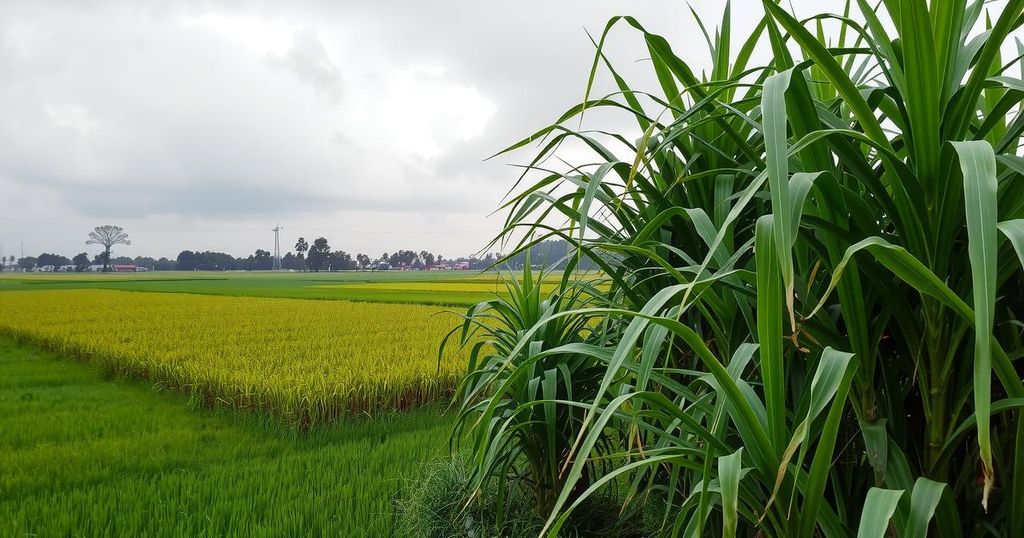New York sugar prices fell on Friday due to rain forecasts in Brazil, easing dryness concerns. Reports indicate lower global sugar production, particularly in Brazil and India, which could influence market dynamics. The International Sugar Organization revised its deficit forecast upward. Coupled with increased production expectations in Thailand, the outlook for sugar prices appears bearish, affected by demand and climatic conditions.
New York sugar prices experienced a decline on Friday, closing down by 0.06 cents (0.31%). Concurrently, London ICE white sugar prices increased slightly by 2.80 cents (0.52%). The downturn in New York prices was attributed to rain forecasts in Brazil, expected to alleviate dryness and enhance sugarcane yields as projected by Somar Meteorologia.
Initially, sugar prices exhibited a rally, reaching two-week highs due to reports of diminished global sugar production. Unica’s recent figures indicated a 5.6% year-on-year decrease in sugar output for the 2024/25 season in Brazil, totaling 39.822 million metric tons. Moreover, the Indian Sugar and Bio-energy Manufacturers Association revised its sugar production forecast for India, dropping it to 26.4 million metric tons from a previous 27.27 million metric tons due to anticipated lower cane yields.
The International Sugar Organization (ISO) revised its global sugar deficit forecast for the 2024/25 season to a deficit of 4.88 million metric tons, highlighting tightening market conditions compared to the prior surplus of 1.31 million metric tons. Additionally, the ISO lowered its global sugar production forecast to 175.5 million metric tons from 179.1 million metric tons, signifying a potential shift in market dynamics.
On the bearish side, a notable decline in demand for sugar was observed after significant deliveries of raw sugar against the March NY futures contract, totaling 1.7 million metric tons from Wilmar International Ltd and Sucres et Denrees SA. This large delivery volume often suggests a weak demand scenario, which adversely affects price stability.
Furthermore, projections from Datagro indicate an expected increase in Brazil’s sugar production to 42.4 million metric tons for 2025/26, representing a 6% rise year-on-year. In a similar vein, Czarnikow anticipated Brazil’s sugar output would reach a record 43.6 million metric tons, with the profitability of sugar production over ethanol becoming increasingly attractive.
In response to prior restrictions, the Indian government announced permission for sugar mills to export 1 million metric tons this season, indicating a potential easing of domestic supply pressures. However, ISMA projected a 17.5% year-on-year decline in India’s 2024/25 sugar production, forecasting a five-year low of 26.4 million metric tons.
Rising production expectations in Thailand, which aims for an 18% increase to 10.35 million metric tons in the 2024/25 season, also appear bearish for global sugar prices. Thailand remains a key global player, being the third-largest sugar producer and second-largest exporter.
Adverse weather conditions, including drought and excessive heat affecting Brazil’s sugar crops, have led to significant harvest reductions. Green Pool Commodity Specialists reported that up to 5 million metric tons of sugar cane may have been lost due to fires in São Paulo, prompting Conab to adjust Brazil’s sugar production estimate downward to 44 million metric tons.
The USDA’s bi-annual report forecasts a 1.5% increase in global sugar production for 2024/25, up to 186.619 million metric tons, alongside a 1.2% rise in human sugar consumption to a record 179.63 million metric tons, while also signaling a decrease in global sugar ending stocks by 6.1%.
Rich Asplund, the author, did not hold any positions in the securities mentioned as of the publication date. The information provided is strictly for informational purposes, and readers are encouraged to familiarize themselves with Barchart’s Disclosure Policy.
In summary, New York sugar prices have decreased due to favorable rain forecasts in Brazil, which could enhance sugarcane yields. Reports indicate global production challenges and an increase in sugar exports from India, despite predictions of lower outcomes. Additionally, rising expectations for sugar production in Brazil and Thailand add a bearish outlook for the market. The current landscape suggests potential market fluctuations influenced by both climatic and economic factors.
Original Source: www.tradingview.com






